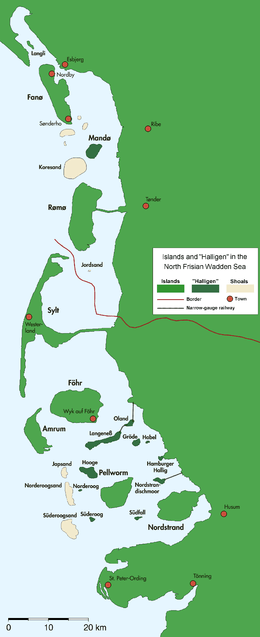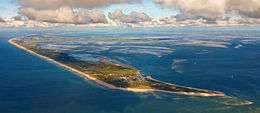North Frisian Islands
 | |
| Geography | |
|---|---|
| Location | North Sea |
| Total islands | 13 |
| Major islands | Sylt, Föhr, Amrum, Pellworm |
| Administration | |
|
Germany | |
| State | Schleswig-Holstein |
| District | Nordfriesland |
| Demographics | |
| Ethnic groups | Germans, Frisians, Danes |

The North Frisian Islands are a group of islands in the Wadden Sea, a part of the North Sea, off the western coast of Schleswig-Holstein, Germany. The German islands are in the traditional region of North Frisia and are part of the Schleswig-Holstein Wadden Sea National Park and the Kreis (district) of Nordfriesland. Occasionally Heligoland is also included in this group.
Sometimes the North Frisian Islands include also the Danish Wadden Sea Islands on the western coast of Jutland, Denmark. Those belong to Tønder municipality and Esbjerg municipality, and are not home to the ethnic group of Frisians.
History
After the Frisian and Danish colonisation of the islands in the 8th century, the Frisian-populated hundreds (between Eiderstedt and Sylt) became the Uthlande. The North Frisians in the Uthlande were ruled directly by the Danish king and were known as Königsfriesen or "King's Frisians". Only later did the Uthlande transfer to the Duchy of Schleswig, with the exception of small Danish royal enclaves. Part of Rømø was also ruled by the Schleswig duke. After the German-Danish wars, the islands from Nordstrand to Rømø became Prussian in 1866. After the referendum in 1920, the current border between the islands of Sylt and Rømø was fixed.
A good and thorough overview of the life, work, languages, costumes and customs of the island Frisians is portrayed by the Carl Haeberlin Frisian Museum in Wyk auf Föhr.
Islands
There are four larger islands and ten tiny islets. The names of the large islands are Sylt, Föhr, Amrum, and Pellworm. The islets are called Halligen. In medieval times the present-day peninsula Nordstrand and Pellworm as well as the Halligen were part of the large island of Strand. This island was torn to pieces in a disastrous storm tide in 1634.
Sylt (Söl'ring North Frisian: Söl' ; Danish: Sild) is the largest of the North Frisian Islands, consisting of about 100 km². It is accessible by a causeway called the Hindenburgdamm; this causeway is only accessible to trains. In the summer months the island is crowded with tourists, including those who have a preference for nudism. Sylt's image is that of a meeting point for the jet-set. The main town on the island is Westerland. The northern end of Sylt, the Ellenbogen ("elbow"), is Germany's northernmost point. Lager Sylt, the Nazi concentration camp on Alderney was named after the island.
Compared with Sylt, Föhr (Fering North Frisian: Feer; Danish: Før) is a relatively silent island. Its area is 82 km². Sixteen old hamlets are scattered over the island, some of which already existed in the 13th century. The main town is Wyk on the south eastern shore. Wyk is a popular German seaside resort. There is no bridge or causeway connecting Föhr and the mainland; so ferries are the only connection. The ferry port, the harbour and Föhr marina are in Wyk.
Amrum (Öömrang North Frisian: Oomram) is only 20 km², but it is popular with tourists, though less crowded than Sylt. The western half of the island features a beach 12 km in length and 1 km in width. The villages are situated on the eastern shore, with Wittdün being the most important of them.
Pellworm (North Frisian Polweerm; Mooring North Frisian: Pälweerm; Danish: Pelvorm) and the peninsula of Nordstrand (Mooring: Nordströön) are the remains of the submerged island of Strand. The main town of this sunken island was Rungholt, thought to be the largest town in the surrounding area, but it was totally destroyed and submerged by a storm in 1362, 272 years before another storm destroyed Strand itself. Nordstrand has an area of 49 km², Pellworm 37 km².
Smaller remains of Strand are the ten islets called Halligen. The houses on these tiny islets are built on artificial hills. In a storm tide only these hills rise above the sea, while the remainder of the islet is flooded. The names of the Halligen are Nordmarsch-Langeness, Norderoog, Süderoog, Nordstrandischmoor, Oland, Südfall, Gröde-Appelland, Hooge, Habel and the Hamburger Hallig.
West off the Halligen, three drying sand banks form the so-called North Frisian Barrier Islands: Japsand, Norderoogsand and Süderoogsand.
See also
| Wikivoyage has a travel guide for North Frisian Islands. |
References
- Wernicke, Klaus; Riecken, Guntram (1992). Nordfriesische Inseln und Halligen [North Frisian Islands and Halligen] (in German). Neumünster: Karl Wachholtz Verlag. ISBN 3-529-05505-0.
- Eckert, Gerhard (1974). Nordfriesische Inseln und Küstenbadeorte [North Frisian Islands and Coastal Resorts] (in German). Frankfurt am Main: Umschau Verlag. ISBN 3-524-00299-4.
- am Zehnhoff, Albert (1979). Sylt, Amrum, Föhr, Helgoland, Pellworm, Nordstrand und Halligen. Natur und Kultur auf Helgoland und den Nordfriesischen Inseln. Entdeckungsreisen durch eine Landschaft zwischen Meer und Festlandküste [Sylt, Amrum, Föhr, Helgoland, Pellworm, Nordstrand and the Halligen. Nature and Culture on Heligoland and the North Frisian Islands. A Discovery Voyage through a Landscape between Sea and Shore.] (in German). Cologne: DuMont. ISBN 3-7701-1093-5.
- Koehn, Henry; Häberlin, Carl; Tedsen, Julius; Warnecke, Georg (1961). Die Nordfriesischen Inseln [The North Frisian Islands] (in German). Berlin: Walter de Gruyter. ISBN 3-11-000564-6.
- Koehn, Henry (1954). Die Nordfriesischen Inseln. Die Entwicklung ihrer Landschaft und die Geschichte ihres Volkstums [The North Frisian Islands. Development of their Landscape and History of their Popular Culture] (in German). Hamburg: Walter de Gruyter.
- Zeisse, O. (1990). Beiträge zur Geologie der Nordfriesischen Inseln [Contributions to the Geology of the North Frisian Islands] (in German) (Reprint of the 1888 original ed.). ISBN 3-86031-121-2.
- Weigelt, G. (1873). Die nordfriesischen Inseln vormals und jetzt. Eine Skizze des Landes und seiner Bewohner [The North Frisian Islands Once and Today. A Sketch of the Land and its Inhabitants] (in German). Hamburg: Meissner.
- Kunz, Harry; Panten, Albert (1997). Die Köge Nordfrieslands [The Polders of North Frisia] (in German). Bredstedt: Nordfriisk Instituut. ISBN 3-88007-251-5.
Coordinates: 54°55′N 8°20′E / 54.917°N 8.333°E
